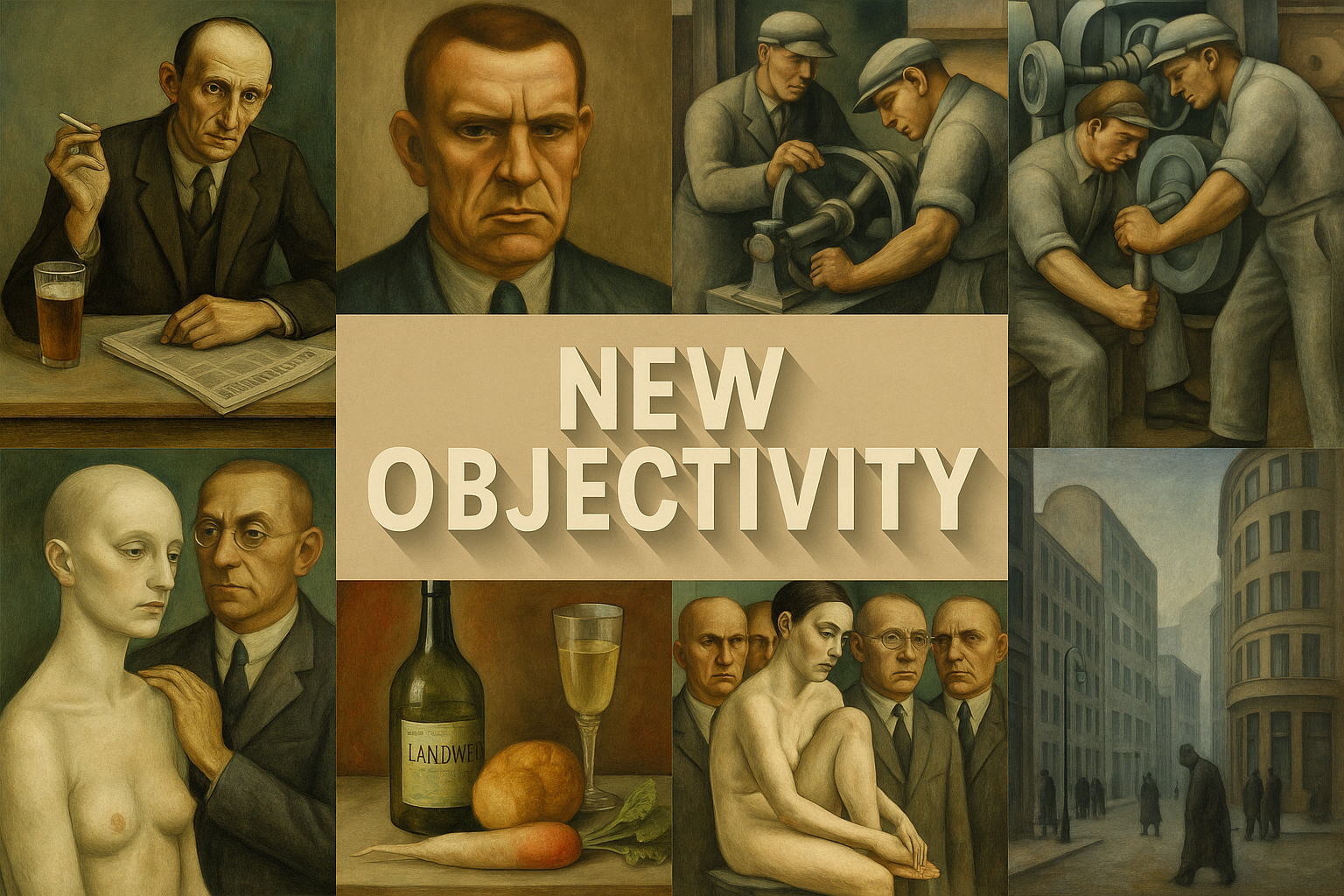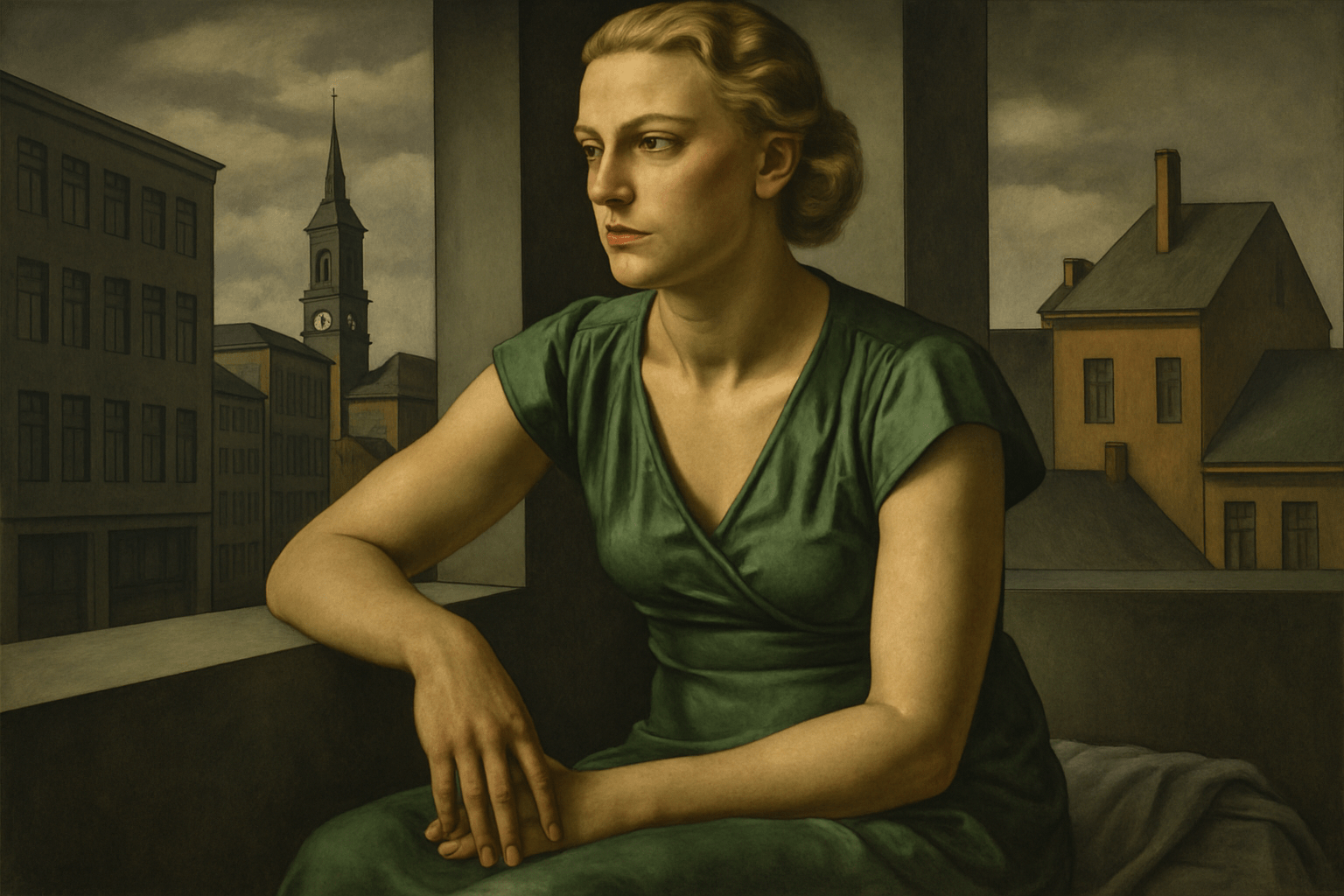
New Objectivity
The art style New Objectivity is characterized by its clean lines and precise details. The colors are often muted and the overall effect is one of order and calm.
AOI thinking about New Objectivity [+_~]-/
Overview and Quickfacts
New Objectivity is a term used to describe a style of art that emerged in the 1920s in Europe. This art style is characterized by its use of realistic and sometimes harsh imagery, as well as its rejection of traditional values. New Objectivity artists sought to depict the world as it really was, without sentimentality or idealization.
Can understand it also, as:
realism, naturalism, verism, objectivism, fact-based art
Categorize it as:
Impressionism, Modernism
.: Dreaming :.
holds a HAIKU for the art style
:. Thought is power .:
Detailed Description
New Objectivity (Neue Sachlichkeit) is a term used to describe a movement in German art that arose in the 1920s as a reaction against Expressionism. The New Objectivity artists sought to depict the world in a realistic and objective manner, eschewing the emotional excesses of Expressionism. This return to realism was also evident in other art movements of the time, such as the American Precisionism. Some of the most famous New Objectivity artists include Max Beckmann, George Grosz, Otto Dix, and Christian Schad. One of the most iconic paintings of the New Objectivity is George Grosz’s “Metropolis” (1928), which depicts the dark and chaotic side of life in the modern city. The New Objectivity was short-lived, coming to an end with the rise of the Nazi party in Germany in the early 1930s. However, the influence of the movement can still be seen in the work of many contemporary artists.
.. beep, beep, beep ..
<START OF TRANSMISSION>
1. New Objectivity was a movement in German art and literature that arose in the 1920s as a reaction against Expressionism. 2. The term "New Objectivity" was coined by art critic Franz Roh in 1925. 3. The New Objectivity artists sought to portray the world in a realistic and dispassionate manner, without the emotional excesses of Expressionism. 4. The movement was particularly prevalent in the visual arts, but it also influenced literature, film, and architecture. 5. New Objectivity artists rejected the idea of art as a vehicle for personal expression, instead believing that art should be objective and factual. 6. They often used photography as a reference tool in their work, and some artists even incorporated photographs directly into their paintings. 7. The New Objectivity has been seen as a response to the trauma of World War I, with its focus on the mundane realities of everyday life. 8. The movement was also shaped by the economic and social changes of the Weimar Republic, such as the rise of the middle class and the spread of mass media. 9. New Objectivity artists often used satire and irony in their work, as a way of critiquing the hypocrisies of society. 10. The most famous New Objectivity artist is probably George Grosz, whose caustic drawings and paintings satirized the corrupt and decadent society of the Weimar Republic. 11. Other notable New Objectivity artists include Otto Dix, Max Beckmann, and Hannah HÃÂöch. 12. The New Objectivity has been seen as a precursor to the Pop Art movement of the 1950s and 1960s. 13. It has also been linked to the rise of Nazi Germany, as some of the artists associated with the movement later joined the Nazi Party or were sympathetic to its ideology. 14. The New Objectivity is sometimes referred to as Neue Sachlichkeit, German for "new matter-of-factness." 15. The movement was at its height in the mid-1920s, but it continued to influence artists and intellectuals in Germany until the early 1930s. 16. The New Objectivity has been the subject of numerous exhibitions in recent years, including a major retrospective at the Tate Modern in London in 2006. 17. The term "New Objectivity" has also been used in other contexts, such as philosophy, to describe a similar approach to reality. 18. The New Objectivity was a major influence on the German artist Gerhard Richter, who is widely considered one of the greatest living painters. 19. The movement has been the subject of numerous books and scholarly articles, and its legacy continues to be debated by critics and historians. 20. The New Objectivity is one of the most important movements in German art and culture, and its impact can still be felt in the work of contemporary artists.
<EOF>
.. robbel bob
Visual Examples from our image gallery
Coming soon, we are so slow .. might never come
Artists, Paintings, and more
(be aware, can be highly speculative)
Artists (be aware, speculation possible):
1. George Grosz (1893-1959) 2. Otto Dix (1891-1969) 3. Max Beckmann (1884-1950) 4. Christian Schad (1894-1982) 5. Rudolf Schlichter (1890-1955) 6. Georg Scholz (1890-1945) 7. Hannah HÃÂöch (1889-1978) 8. John Heartfield (1891-1968) 9. Jeanne Mammen (1890-1976) 10. Conrad FelixmÃÂüller (1897-1977) 11. Elfriede Lohse-WÃÂächtler (1899-1940) 12. Erich Heckel (1883-1970) 13. Karl Hubbuch (1891-1979) 14. Ludwig Meidner (1884-1966) 15. Max Pechstein (1881-1955) 16. Oskar Schlemmer (1888-1943) 17. Paul Klee (1879-1940) 18. George Grosz (1893-1959) 19. Otto Dix (1891-1969) 20. Max Beckmann (1884-1950) 21. Christian Schad (1894-1982) 22. Rudolf Schlichter (1890-1955) 23. Georg Scholz (1890-1945) 24. Hannah HÃÂöch (1889-1978) 25. John Heartfield (1891-1968) 26. Jeanne Mammen (1890-1976) 27. Conrad FelixmÃÂüller (1897-1977) 28. Elfriede Lohse-WÃÂächtler (1899-1940) 29. Erich Heckel (1883-1970) 30. Karl Hubbuch (1891-1979)
Artworks (be aware, speculation possible)
1. “Nude with Blue Stockings” by George Grosz (1923) 2. “The Dancers” by Otto Dix (1925) 3. “The Skat Players” by Max Beckmann (1920) 4. “The Trench” by Otto Dix (1924) 5. “The War” by Ernst Kirchner (1915) 6. “Self-Portrait as a Soldier” by Ernst Kirchner (1915) 7. “Berlin Street Scene” by Ernst Ludwig Kirchner (1913) 8. “Nude” by George Grosz (1920) 9. “Two Men in Front of a CafÃÂé” by George Grosz (1920) 10. “CafÃÂé Scene” by George Grosz (1920) 11. “The Potsdamer Platz” by George Grosz (1920) 12. “The Street” by George Grosz (1920) 13. “The Critic” by George Grosz (1920) 14. “The Artist’s Mother” by George Grosz (1920) 15. “Portrait of the Artist’s Wife” by George Grosz (1920) 16. “The Streetwalker” by George Grosz (1920) 17. “Nude” by Otto Dix (1920) 18. “War Cripples” by Otto Dix (1920) 19. “The Skat Players” by Otto Dix (1920) 20. “The Trench” by Otto Dix (1924) 21. “The War” by Ernst Kirchner (1915) 22. “Self-Portrait as a Soldier” by Ernst Kirchner (1915) 23. “Berlin Street Scene” by Ernst Ludwig Kirchner (1913) 24. “Nude” by George Grosz (1920) 25. “Two Men in Front of a CafÃÂé” by George Grosz (1920) 26. “CafÃÂé Scene” by George Grosz (1920) 27. “The Potsdamer Platz” by George Grosz (1920) 28. “The Street” by George Grosz (1920) 29. “The Critic” by George Grosz (1920) 30. “The Artist’s Mother” by George Grosz (1920)
Epoch
The New Objectivity art style emerged in the 1920s and lasted until the early 1930s.
AI ART RESSOURCES (AKA, well Tools)
Helping tools -> predefined search links on other pages:











